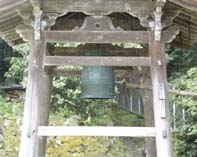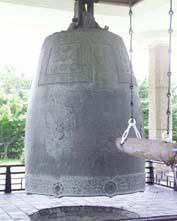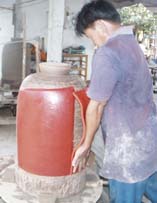| 
Japanese Bell

The Emille Bell in Kyong-ju, Korea
|
The word Buddha means to awaken, and so sound of bells is central to Buddhist practices.
Through Buddhism, and its spread through Asia, the large temple bell evolved and was eventually taken up in the West. Buddhist temple bells have evolved into slightly different shapes in the various regions of East and South East Asia. They are generally fairly cylindrical in shape and have a thickened rim around the mouth of the bell.
Buddhist bells are usually struck by large logs of wood suspended horizontally beside the bell. These must be large enough to excite the fundamental frequency of the bell, and not too hard, so that the lower frequency modes are the most prominent in the sound. The nipples found on Japanese and Korean bells, and other surface details generally found on Buddhist bells have important spiritual significance, but are unlikely to make an audible difference to the sound of the bell.
Large Buddhist bells are usually heard in isolation, and their sound is complex and varied. However smaller untuned bells are arrayed in large sets around temples in Thailand. Devotees strike each bell for the forgiveness of a sin as they ascend the temple, and the complexity of the resulting sounds are extraordinary.
Creating a bell timbre that is predictable, as in European bells, is only important if the bells are to be used in a musical set. As Buddhist practices, are diverse so are the shapes and sounds of their bells. Australian Bell seeks the opportunity to work with various Buddhist communities to design and cast ideal bells for their spiritual practice.
|
|
|
|
Cambodian Bells at the Asten Bell Museum in Holland |
Thia bells at a temple near Chiang-mai |
A Ming dynasty Chinese bell in the Beijing Bell Museum |
Typical Japanese Boncho bells at Iwasawa foundry in Kyoto (a Korean style bell is in the foreground) |
BELL CASTING IN ASIA
As in Europe there are two main approaches to casting bells in Asia, although almost identical methods are to be found. At the Japanese foundries, Iwasawa and Oigo works we observed a method similar to those used in England, while in Thailand false bells were made in wax as in Dutch foundries. At the Beijing Bell museum we documented an extraordinary Ming dynasty bell of about one tonne mass that was clearly cast from a false bell featuring dragons in deep relief across its surface (shown above).
 |
 |
| Assembling a mould at Iwasawa foundry in Kyoto |
Creating a wax bell over the core in Chang-mai, Thailand |
|

.jpg)

.jpg)